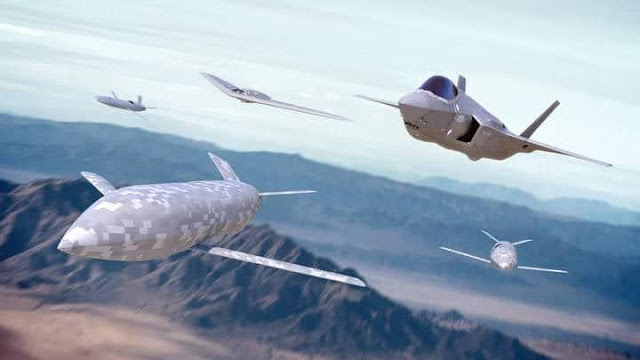
|
| F-35 fly with loyal wingman - NGAD Program |
- Next Generation Air Dominance (NGAD) manned fighter will be made independently by US Air Force. But Air Force officials have hinted that the US and its allies might work together to develop technologies.
- NGAD's open mission system backbone could give international defense companies more chances to "drive competition".
- Japan and the United Kingdom are working together on an air combat sensor suite. Australia has been making investments in the development of its own Loyal Wingman-style drone.
- Kendall has indicated she is interested in the MQ-28 Ghost Bat, which is Australia's version of a drone.
But Air Force officials have hinted that the US and its allies might be able to work together to develop technologies that could be "associated" with future tactical aircraft, like the collaborative combat aircraft (CCA) drones that will work alongside the Next Generation Air Dominance (NGAD) manned fighter and the mission systems inside the fighter itself.

|
| NGAD Flight Demonstrator |
At the Defense News Conference last month, Air Force Secretary Frank Kendall said, "NGAD may involve international partnerships." Kendall also said that international cooperation would be "very limited."
He said, "I just got back from trips to Australia and Japan, and earlier this year I was in the UK." "We've talked to all of those countries about their interest in the project in a preliminary way." "The unmanned Collaborative Combat Aircraft seems to be getting a lot of attention."
The US Air Force plans to use its next-generation air superiority aircraft as part of the NGAD "family of systems," which will also include a variety of CCA drones and next-generation weapons and mission systems.
Air Force Chief of Staff Gen. CQ Brown said that during a meeting at the Royal International Air Tattoo in July, he and his UK counterpart, Air Chief Marshal Michael Wigston of the Royal Air Force, talked "conceptually" about possible ways to work together.
In a recent interview, Brown said, "There's probably some chance [for co-development] as you move forward with different mission systems, as we work with NGAD and the UK works with Tempest." Tempest is the UK's fighter program for the sixth generation. It will be part of a group of systems that are similar to NGAD.
Even though the discussion didn't say where the two air forces could develop technologies together, Brown said that NGAD's open mission system backbone could give international defense companies more chances to "drive competition" over the course of the program's life.
If the US Air Force wants to work with other countries on parts of NGAD, the UK, Australia, and Japan are the best places to start those talks.
The most important question to ask is, "Does anybody in the Air Force really want to adapt their requirements to somebody else's?" Aboulafia said. "It doesn't seem likely to me. However, this does not imply that there are no possibilities for working together."
The United Kingdom and Japan came to an agreement about developing a joint engine demonstrator for the Tempest program and the Japanese F-X initiative last year. Although it is unlikely that the United States Air Force will participate in this project (since it is currently working on creating its own NGAD engine as part of the Next Generation Advanced Propulsion initiative), Japan and the United Kingdom are currently working together on an air combat sensor suite known as Jaguar, which the United States may find interesting.
And in the realm of unmanned aviation, the United Kingdom is considering the possibility of operating combat drones that can collaborate with other nations.
Japan in another Loyal Wingman
In the meantime, Japan could be considered something of an unknown quantity in
terms of what it has to offer.
According to Aboulafia, "Japan, years ago,
was really up front with the first AESA [active electronically scanned array]
radar and the first co-cured composite wing on the F-2." However, in
subsequent years, Japan has not placed an emphasis on developing leap-ahead
defense technology. The field of artificial intelligence is "a key missing
variable" for CCA, which is one of the areas in which Japan has the potential
to become a leader in technological innovation. Kendall has indicated that she
is interested in the MQ-28 Ghost Bat, which is Australia's version of a drone
similar to Loyal Wingman. In the meantime, Australia has been making
investments in the development of its own Loyal Wingman-style drone. The Royal
Australian Air Force, in contrast to the efforts being made to develop drones
in the United Kingdom, has already begun testing and flying prototypes of the
MQ-28, which are manufactured in the United States.

